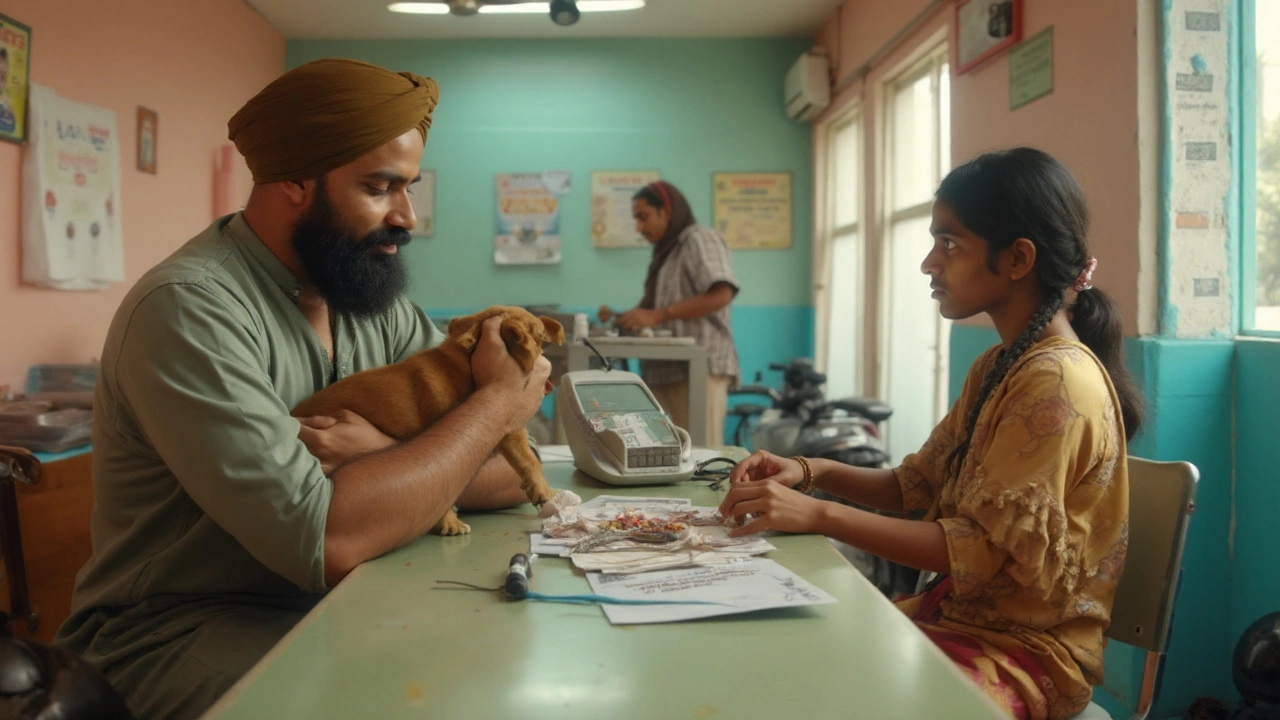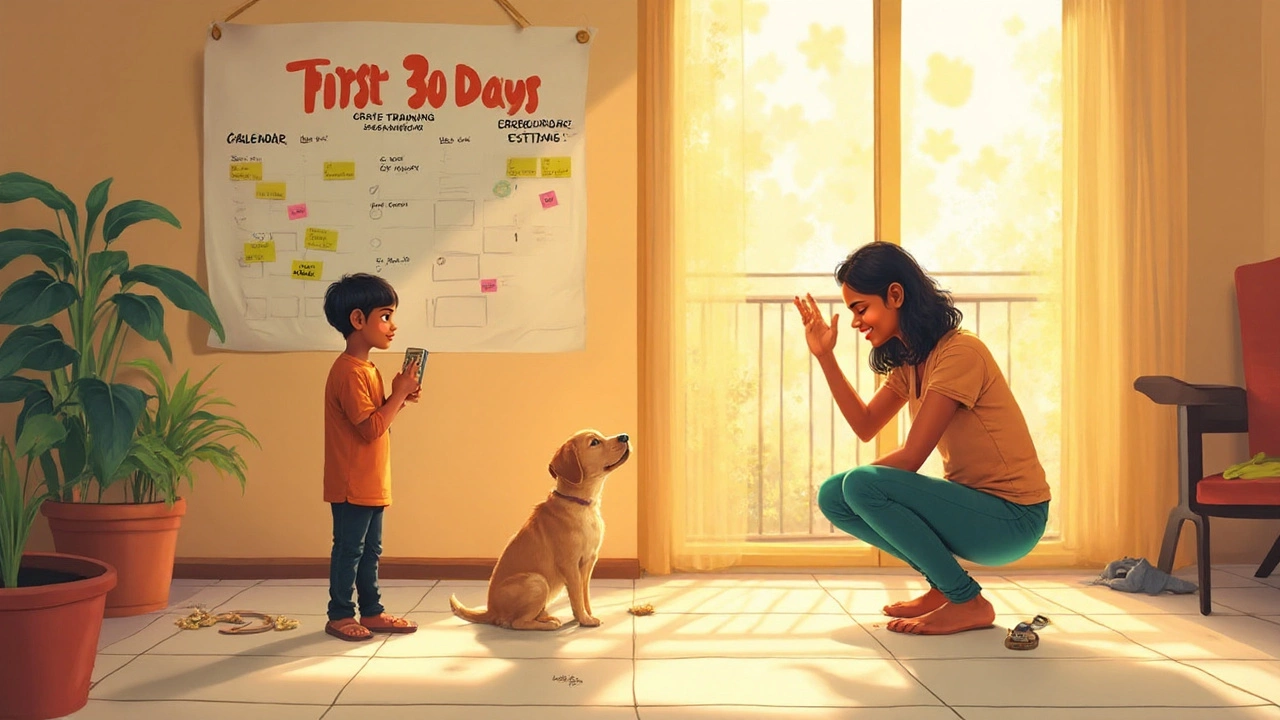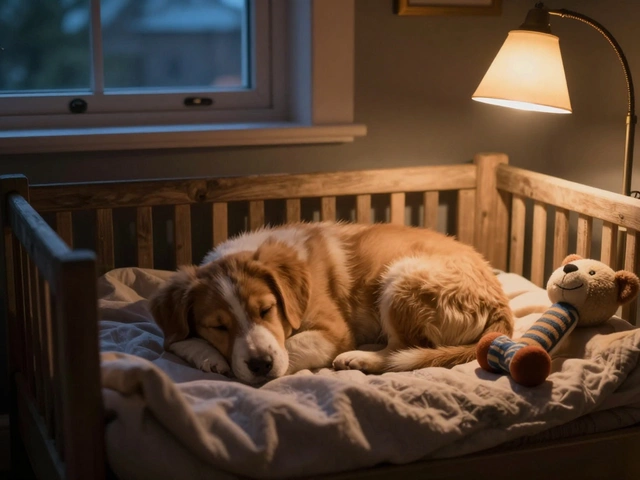
You’ve seen the cute photos. What you haven’t seen is you, in socks at 2 a.m., standing in the rain, begging a tiny gremlin to pee. That gap between the fantasy and the first month is where most new owners struggle. Here’s the honest version-mess, money, sleep, setbacks-and a simple plan that actually works. This is real puppy care, not Instagram.
- TL;DR: Puppies bring joy and chaos. Expect sleep disruption (2-4 weeks), toilet accidents, biting, and surprise costs (NZD $2-4k first year). A calm, boring routine wins. Start crate training day one, socialization by week two, vet care on schedule, and short daily training. You’ll get your life back in about 6-12 weeks.
- Big risks to manage: Parvovirus (NZ risk is real), leash reactivity if you miss the socialization window, and preventable vet bills if you skip insurance.
- Wins come from: structure (same wake/meal/potty times), bite-management not punishment, tiny training reps, early alone-time practice, and proactive socialization.
- Local angle: In New Zealand, dogs must be registered with your council by 3 months old. Microchipping is required for first-time registrations (Dog Control Act 1996). Leptospirosis vaccination is common in Auckland.
What you probably want right now:
- Know the ugly-but-fixable stuff most guides gloss over.
- A day-by-day plan for the first month.
- Schedules for workdays vs weekends in a normal home.
- Shopping and socialization checklists so you don’t miss something critical.
- Fast answers to common “is this normal?” questions.
The Stuff No One Tells You
Sleep gets weird. For the first 2-3 weeks, expect night wake-ups every 2-4 hours. A young puppy can’t hold their bladder long. A rough rule: hours they can hold = their age in months, plus one. So a 2-month-old might last 3 hours overnight. That’s normal, not a training failure.
Toilet training is a numbers game, not a punishment game. When awake, puppies often need to pee every 20-30 minutes, and definitely after waking, eating, playing, or drinking. If you take a puppy out 8 times a day, you’ll still have accidents. If you take them out 20 times, you’ll have far fewer. The win is frequency plus supervision.
Chewing and biting will spike before they get better. Your puppy isn’t “aggressive.” Their mouth is how they test the world. Expect tooth-on-skin several times a day until 4-5 months. Management beats scolding: rotate 3-4 high-value chews (frozen Kongs, braided bully sticks, rubber toys), use a tether or baby gates, and park the puppy on a mat with a chew during human meals.
Socialization isn’t just “meeting lots of dogs.” It’s calmly exposing your puppy to sounds, surfaces, people, and places during the prime window (about 3-14 weeks, with a useful extension to 16 weeks). Miss this, and you may fight fear and reactivity later. In Auckland, that includes buses, scooters, ferries, rain, loud wind, skateboards, hi-vis vests, and kids on netball courts.
Vaccines matter-and timing does, too. NZ sees regular parvo clusters. The NZ Veterinary Association (NZVA) standard: core puppy shots at 6-8, 10-12, and 14-16 weeks, with a 12-month booster. Many Auckland vets also recommend leptospirosis due to rats/waterways. Ask your vet; SPCA NZ and MPI back evidence-based schedules.
Insurance has waiting periods. If you sign up after your puppy gets an ear infection, that ear is a pre-existing condition. Most policies have 14-30 day illness waits and 48-hour accident waits. Read the exclusions. Pet insurance averages roughly NZD $40-100/month depending on breed and excess. It can save you thousands on emergencies.
Council registration and microchipping are not optional. In New Zealand, dogs over 3 months must be registered with your local council, renewed every year (the dog registration year runs 1 July-30 June). First-time registrants must be microchipped (working farm dog exceptions exist). Check Auckland Council for fees and due dates; late fees add up fast.
Your routine runs the household. Puppies thrive on predictable wake-up, toilet, feed, play, and sleep blocks. If every day looks different, you’ll get accidents and whining. Calm, boring structure now equals freedom later.
You’ll feel “puppy blues.” It’s common to feel regret, frustration, or a dent in your relationship in the first month. Sleep loss plus constant supervision is intense. It passes. Split night shifts, keep expectations low, and celebrate small wins: a nap in the crate, a quiet settle on the mat, a first successful walk.
Your First 30 Days Plan
Here’s a simple plan that works in a normal home, whether you’ve got a backyard or a small balcony.
Day 0-3: Settling in
- Pick a toilet spot outside (or a grass patch on a balcony). Take the puppy there on lead every wake, eat, play, drink. Say nothing while they sniff. Quiet praise and treats after.
- Crate day one. Feed meals in the crate, door open. Do 3-5 naps per day in the crate: start with 5-10 minutes, build to 30-60 minutes. Cover partially with a light sheet to reduce stimulation.
- Night plan. Set an alarm at 3-hour intervals. Scoop puppy up, outside/to the pad, minimal talk, back to bed. If they whine in the crate, try moving it beside your bed the first nights.
- Alone time. Two to three micro-sessions daily: 1-3 minutes behind a baby gate with a stuffed Kong, you in sight. Goal: absence is normal.
- Vet booked. Book puppy check and vaccine update in the first week. Ask about leptospirosis in your area and parasite control (fleas/worms).
Week 1-2: Foundations
- Toilet training: out every 30-60 minutes when awake. Use a timer. If accidents happen, clean with an enzymatic cleaner. Don’t scold; you’ll only teach them to hide it.
- Chew strategy: 3-4 chews on rotation, 15-20 minutes each, 2-3 times daily. Freeze wet food in a Kong for a longer chew that calms.
- Handling: daily 2-minute sessions touching ears, paws, tail, gently pairing with treats. Your groomer and vet will thank you.
- Training tiny wins: name recognition, hand target (nose-to-hand), sit, and “drop it.” Keep sessions 1-3 minutes, 2-4 times/day.
- Socialization starts: carry your puppy in high-risk areas until vaccines are complete. Invite one or two fully vaccinated, friendly adult dogs to your yard/home for calm greetings. Observe, don’t overwhelm.
Week 2-3: Expanding the world
- Short outings: 5-10 minutes to quiet places-drive to a car park, watch the world from the boot; stand outside a school at pickup far enough away to keep your puppy calm; sit at a cafe with a mat, treat for looking at bikes/scooters.
- Leash basics: start indoors or on the lawn. Reward for staying near your knee. Practice 2-3 minutes, 2-3 times/day. No tug-of-war with the leash.
- Alone-time reps: build to 5-10 minutes out of sight with a safe chew. If they panic, you went too fast. Step back to where they’re quiet and rebuild.
- Crate comfort: aim for one 60-90 minute nap per day in the crate, plus overnight. If nights are rough, try a warm rice sock, white noise, and a last toilet break right before lights out.
Week 3-4: Real-life practice
- Walks on the ground: after your vet clears you post-vaccines, start with 10-15 minutes max. Keep it positive. Let the puppy sniff-it’s brain work.
- “Settle” on a mat: feed 5-10 kibble for staying on the mat while you sip coffee or type. Add duration in 10-20 second chunks.
- Meet the world: hats, masks, wheelchairs, pushchairs, tradies, buses (from a safe distance). Treat for calm looks. Keep sessions short and end before they’re overwhelmed.
- Skills that prevent reactivity: reward for checking in with you when another dog appears; do a U-turn; step off the path and scatter-feed while the other dog passes.
Always-on guardrails
- Prevention first: gates, tethers, crates. Freedom expands with earned reliability.
- Bite mitigation: stop rough play before it peaks; swap to a chew; end the session calmly if the puppy ramps up.
- Consistency beats intensity: 5 minutes a few times a day outperforms a Saturday crash course.
- Health: follow the vaccine plan, deworm on schedule, keep flea control regular. The NZVA and SPCA publish up-to-date guidance-ask your vet for a printed plan.

Real-World Examples and Schedules
Two sample days. Adjust as needed for your puppy’s age and your life.
Example A: 8-10 week-old in an apartment (Auckland CBD)
- 6:30 am: Outside to toilet (carry to reduce indoor accidents if needed). Breakfast in a snuffle mat.
- 7:00 am: 3-minute training (name, sit). Short play. Toilet.
- 7:30 am: Crate nap 60 minutes. You shower, answer emails.
- 8:45 am: Toilet. Calm carry to street; watch buses/cyclists from a distance. Treat for calm looks.
- 9:15 am: Chew session (frozen Kong) on a mat while you work nearby. Toilet after.
- 10:00 am: Crate nap 90 minutes.
- 12:00 pm: Toilet. Lunch split if your vet recommends 3 meals/day. Handling practice (paws/ears).
- 12:30 pm: Short indoor leash session, 2-3 minutes. Toilet.
- 1:00 pm: Nap. You get stuff done.
- 3:30 pm: Toilet. Calm visitor comes by; puppy gets treats for greeting nicely. End before overtired.
- 4:00 pm: Chew on mat while you cook. Toilet.
- 5:30 pm: Dinner. Gentle play. Toilet.
- 6:30 pm: Wind-down: lick mat, dim lights. Final toilet at 9:30-10:00 pm, then bed.
Example B: 12-14 week-old, house with yard (West Auckland)
- 6:00 am: Outside toilet. Breakfast scatter-fed on the lawn.
- 6:30 am: Short walk on quiet street (10 minutes after vet clearance). Reward check-ins.
- 7:00 am: Nap.
- 9:00 am: Training (hand target, drop it). Toilet.
- 10:00 am: Car ride to a new park. Watch kids from a distance. Treat for calm.
- 11:00 am: Nap in crate.
- 1:00 pm: Toilet. Play with a known, vaccinated adult dog in your yard.
- 2:00 pm: Chew. Nap.
- 5:00 pm: Dinner. Mat settle while family eats.
- 7:00 pm: Evening toilet, quick sniffari in the yard.
- 10:00 pm: Last toilet. Bedtime.
Working 9-5? Options
- Staggered care the first 2-4 weeks: work from home part days if possible.
- Hire a trusted puppy sitter for midday toilet/training visits.
- Use a playpen with a safe surface, water, and a bed; never leave for a full workday at 8-10 weeks. Build tolerance slowly.
- Avoid busy daycares at this age; many require full vaccinations and can overwhelm a young puppy.
Checklists, Heuristics, and Cost Table
Shopping list (skip the gimmicks)
- Crate sized for adult with a divider; bed that fits in crate.
- Playpen and 2-3 baby gates.
- Flat collar with ID, harness that won’t rub, 1.8-2m leash.
- 4-6 chew options (rubber toy, nylon bone, natural chew), lick mat, snuffle mat.
- Training treats (soft, pea-sized), food storage container.
- Enzymatic cleaner, poop bags, brush/nail file or grinder.
- Car restraint (crate or seatbelt harness).
Toilet training cheat sheet
- When to go: after waking, eating, playing, or every 30-60 minutes when awake.
- Where: same spot, on lead, minimal chatter.
- Reinforce: treat within 2 seconds of finishing, outside.
- If accident: interrupt softly, guide outside. Clean with enzyme cleaner.
- Goalposts: 3 clean weeks indoors before you say “house trained.”
Socialization bingo (aim for 3-5 new, calm exposures/day)
- Sounds: buses, scooters, trains, thunder, fireworks (at a distance with treats).
- Surfaces: wet grass, gravel, metal grates, sand, wooden decks.
- People: hats, beards, hi-vis jackets, kids, umbrellas.
- Animals: calm adult dogs you know are vaccinated; watch ducks from afar.
- Places: cafe patio, school gates, car washes (from a distance), ferry terminal observation.
Heuristics that save sanity
- 1 hour rule: awake time for very young pups is often 45-90 minutes before they need a proper nap.
- 3 strikes rule: if your puppy ignores you 3 times, the environment is too hard. Move farther away or go home.
- Chew quota: 2-3 chew sessions/day reduces biting and chaos by half.
- Freedom follows reliability: one room at a time; earn the lounge after 1 week accident-free there.
- Training dose: 5 minutes, 3-5 times/day beats one long session.
| Cost/Time | Typical Range (NZD/Auckland) | Notes |
|---|---|---|
| Adoption/Purchase | $200-$500 (rescue) / $1,500-$4,500+ (breeder) | Reputable breeders include early vet care; ask for health tests. |
| Initial Vet (exam + vaccines) | $120-$300/visit | 3 core puppy shots + 12-month booster; leptospirosis often advised in Auckland. |
| Microchip | $50-$80 | Mandatory for first registration (Dog Control Act 1996). |
| Council Registration | $70-$160/year | Varies by council; discounts for desexed dogs; penalties for late payment. |
| Insurance | $40-$100/month | Check waiting periods and exclusions; higher for some breeds. |
| Food | $60-$150/month | Depends on size and brand; large breeds cost more. |
| Training Class (6 weeks) | $200-$350 | Look for positive reinforcement; ask about trainer credentials. |
| Grooming | $90-$140/visit | Every 6-8 weeks for poodle mixes; brush at home between visits. |
| Parasite Control | $15-$40/month | Fleas, ticks (seasonal), worms; vet can bundle products. |
| Setup Gear | $300-$600 | Crate, gates, harness, leash, chews, bowls, cleaner. |
| Time Investment | 3-5 hrs/day first month | Broken into toilet trips, training, play, and naps. |

Mini-FAQ and Next Steps/Troubleshooting
Can I take my puppy out before all vaccines? Yes, with care. Avoid dog parks, pet store floors, and high-dog-traffic verges. Carry them in busy spots, meet known vaccinated adult dogs at home or in your yard, and do “sight-seeing” of the world from safe distances. Parvo risk in NZ is real; ask your vet about safe zones and timing.
How long can I leave my puppy alone? As a guide: 8-10 weeks: 30-60 minutes; 3 months: up to 2-3 hours; 6 months: 4-5 hours; adult: aim for 6-8 hours max, with a break. Build slowly. If they panic, shorten and add a stuffed Kong.
My puppy cries all night. What now? First, rule out toilet needs. Try moving the crate beside your bed for a few nights. Use a warm rice sock and white noise. Keep night trips silent. Reward quiet, not screaming. Most pups settle in 3-7 nights with structure.
Is biting normal? Yes. Redirect to a chew. Stop play when the puppy escalates. Teach a calm “drop it” and “find it” game. If biting escalates or targets faces hard, get help from a qualified force-free trainer.
When should I desex? Talk to your vet about breed and timing. Many NZ vets recommend around 6-12 months, with large breeds sometimes later to support joint development. Check council discounts for desexed dogs.
What if my landlord says no? In NZ, tenancy agreements often restrict pets. Get written permission before you adopt. Offer a pet CV (training plan, references, proof of flea control) and a higher bond if legal. Rehoming because of a lease is heartbreaking-sort it first.
How do I stop accidents? Increase frequency out, reduce freedom, and watch for pre-pee signals (circling, sniffing). If you catch them mid-pee, calmly scoop and go outside. No yelling after the fact; they won’t connect it.
My puppy isn’t eating. New environment stress is common. Warm the food a little, hand-feed 10-20 kibbles to spark appetite, use a lick mat. If they skip more than 24 hours, vomit repeatedly, or seem flat, call the vet.
Loose stools-panic? Mild loose stools can happen with stress or food changes. If there’s blood, repeated vomiting, lethargy, or your puppy hasn’t had full parvo protection, contact your vet immediately.
Leash pulling already? Reward position next to your knee at home first. On walks, stop when they pull, move when there’s slack. Use a well-fitted harness. Keep early walks short and full of rewards.
Next steps by scenario
- First-time owner, apartment: prioritize crate training, chew strategy, and elevator/hallway socialization. Carry outside until vaccine clearance; build a balcony grass patch.
- Family with kids: teach “give the puppy space” and “toy swap” rules. Short, supervised play. Crate is the puppy’s safe zone-no kid access.
- Shift worker: anchor 2-3 key rituals (morning toilet + breakfast, midday break, bedtime settle). Use a dog walker or trusted sitter for the long gaps.
- Multi-dog home: gates for decompression, 1:1 training with the puppy daily, and calm parallel walks before off-lead play.
- On a budget: adopt from SPCA or reputable rescues, buy second-hand crates, prioritize insurance and vaccines over fancy gear.
When to get professional help
- Persistent night panic after 10-14 days despite structure.
- Guarding food/toys/body from people early and often.
- Extreme fear or freezing in normal settings.
- Ongoing diarrhea, vomiting, or lethargy, especially in under-16-week pups.
Who to trust in New Zealand
- Your local vet: vaccine schedules, parasite control, desexing timing.
- NZVA: evidence-backed health guidance.
- SPCA NZ: welfare-first advice and training basics.
- Ministry for Primary Industries (MPI): animal welfare standards.
- Auckland Council (or your council): registration rules, deadlines, and dog bylaws.
The short version: you’ll be tired, you’ll spend more than you planned, and you’ll feel in over your head for a bit. Stick to a boring routine, protect sleep, pump the socialization (calm, short, daily), and keep training tiny and fun. Around the 6-8 week mark, the clouds part. Around 6 months, you’ll wonder how you ever lived without this dog.





